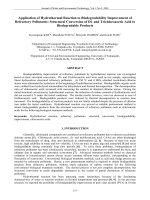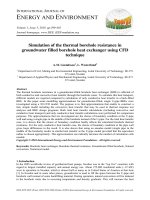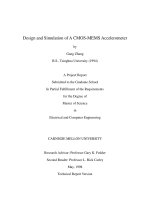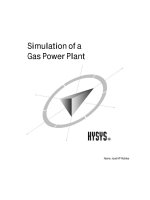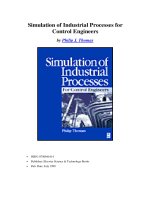SIMULATION OF DYNAMIC BEHAVIOR OF HOVERCRAFT HULL STRUCTURAL SUBJECTED TO UNDERWATER EXPLOSION SHOCKWAVE mô PHỎNG TÍNH TOÁN THUỘC TÍNH ĐỘNG lực học của mô HÌNH tàu đệm KHÍ dưới tác ĐỘNG SÓNG sốc gây RA bởi vụ nổ dưới nước
Bạn đang xem bản rút gọn của tài liệu. Xem và tải ngay bản đầy đủ của tài liệu tại đây (595.72 KB, 8 trang )
Kỷ yếu hội nghị khoa học và công nghệ toàn quốc về cơ khí - Lần thứ IV
SIMULATION OF DYNAMIC BEHAVIOR OF HOVERCRAFT HULL
STRUCTURAL SUBJECTED TO UNDERWATER EXPLOSION
SHOCKWAVE
MÔ PHỎNG TÍNH TOÁN THUỘC TÍNH ĐỘNG LỰC HỌC CỦA MÔ HÌNH TÀU
ĐỆM KHÍ DƯỚI TÁC ĐỘNG SÓNG SỐC GÂY RA BỞI VỤ NỔ DƯỚI NƯỚC
Nguyen Ngoc Kien1a, Hai-Anh Nguyen2b
Hanoi University of Science and Technology, Hanoi, Vietnam
2
National Chiao Tung University, Hsinchu, Taiwan
a
;
1
ABSTRACT
A hovercraft, also known as an air-cushion vehicle or ACV, is a craft capable of
traveling overland, water, mud or ice and other surfaces. Hovercraft must be designed to
survive in the extreme loading conditions, such as an underwater explosion (UNDEX).
However, for the previous study, the UNDEX response was primarily studied focus on ships,
submarines and the other submerged structures. For this reason, this study selected a finite
element model based Zubr-class like LCAC (Air-cushioned landing craft) subjected to
UNDEX, dynamic responses of structure analysis were conducted. This study develops a
procedure which links together the finite element method (FEM) and Acoustic-Structure
Coupling (ASC) method to simulate an UNDEX by using ABAQUS software and
investigated the survival capability of a damaged craft. The explosive charge of TNT (9 kg)
were located 10 m on the normal line passing through the center of hovercraft model. The
characteristic of body structure and skirt response of the hovercraft model are discussed. The
numerical results show that the structure of hovercraft sustains severe local response
especially is the main deck and skirt. The analytical results offer a valuable reference to the
research of underwater explosion.
Keywords: Underwater Explosion, Hovercraft, Modeling and Simulation, Shockwave
TÓM TẮT
Tàu đệm khí được biết đến như một phương tiện di chuyển nhờ lớp đệm không khí (aircushion vehicle - ACV). Nó có khả năng di chuyển trên bộ, mặt nước, đầm lầy, băng đá và
một số bề mặt phức tạp khác mà tàu thường khó có thể di chuyển được. Nhìn chung, tàu đệm
khí phải được thiết kế để tồn tại được trước những tác động nguy hiểm bên ngoài, như các tác
động gây ra bởi một vụ nổ dưới nước. Trong những nghiên cứu trước, nghiên cứu về nổ dưới
nước chủ yếu tập trung cho tàu thuyền, tàu ngầm và các cấu trúc ngập nước khác. Vì vậy
trong nghiên cứu này, một mô hình phần tử hữu hạn dựa trên nguyên mẫu tàu đệm khí Zubr
dưới tác động của vụ nổ dưới nước, các phản ứng động lực học về cấu trúc của tàu được phân
tích. Nghiên cứu này được phát triển từ phương pháp phần tử hữu hạn (FEM) và phương pháp
Acoustic-Structure Coupling (ASC) nhằm mô phỏng một vụ nổ dưới nước bằng phần mềm
ABAQUS nhằm đánh giá khả năng hư hại của thân tàu. Với 9 kg chất nổ TNT được đặt ở
dưới nước cách đáy tàu 10 m và thuộc đường thẳng đứng đi qua điểm chính giữa của tàu. Tác
động gây ra bởi sóng sốc lên phần thân tàu và phần váy của tàu được trình bày và đánh giá.
Kết quả mô phỏng cho thấy cấu trúc của tàu trải qua các tác động hư hại mang tính cục bộ,
đặc biệt là tại vị trí sàn tàu và phần váy đệm khí. Các kết quả của phân tích này cung cấp một
tài liệu tham khảo hữu ích cho nghiên cứu về nổ dưới nước.
Từ khóa: nổ dưới nước, tàu đệm khí, mô hình hóa và mô phỏng, tải trọng sốc.
913
Kỷ yếu hội nghị khoa học và công nghệ toàn quốc về cơ khí - Lần thứ IV
1. INTRODUCTION
In this research, a full-scale hovercraft subjected to underwater explosion simulation is
presented. Shock analyzes were conducted using a finite element based coupled Zubr-class
like LCAC with a fluid model and an underwater explosion simulation that detonates 9 kg of
TNT. Zubr-class hovercraft shock modeling and simulation has been performed. The
investigation is accomplished via the validation of the Acoustic-Structure Coupling (ASC)
method in an underwater explosion. During underwater explosion (UNDEX), the sudden
release of energy from a conventional high-explosive or nuclear weapon generates a
shockwave and forms a superheated, highly compressed gas bubble in the surrounding water.
For example, approximately 53% of the total energy released from a 1500 lb (680.39 kg)
Trinitrotoluene (TNT) UNDEX is applied to the shockwave and 47% is applied to bubble
pulsation [1]. The primary concern in naval engineering and offshore structure research is
predicting how submerged structures are damaged by UNDEX. Numerical methods for
analyzing submerged structures exposed to UNDEX shock loadings have been successfully
implemented. For example, Shin [2] presented ship shock modeling and simulation for farfield underwater explosion by applying the LS-DYNA code coupled with USA code (2004).
Liang and Tai [3] presented a preliminary study of the transient responses of a 2000-ton patrol
boat with shock loading using the finite element method (FEM) coupled with the second
Doubly Asymptotic Approximation (DAA2) (2006). Jin and Ding [4] presented numerical
simulations of a ship section dynamically responding to a non-contact UNDEX by using
ABAQUS (2011). Zong, Zhao and Li [5] conducted a numerical study of whole ship
structural damage caused by close-in UNDEX shock (2013). Wang, Zhu, Cheng and Lin [6]
examined the dynamic response of ship structures with the combined effect of shock wave
load and bubble pulsation subjected to close-in non-contact UNDEX (2014). Gong and Khoo
[7] presented a stiffened composite submersible hull subjected to underwater explosion
bubble, the coupled BEM-FEM is used to handle the interaction of the composite structures
and the underwater explosion bubble, mutual effects of relative location between the bubble
and the composite submersible hull are investigated. However, all of the aforementioned
literature the UNDEX response was primarily studied for ships and submerged structures; no
studies exist on dynamic responses of an air cushion vehicle (ACV). For that reason, applying
an UNDEX situation to ACV is the main issue of this research. The response of a hovercraft
Russian Zubr-Class model 1232-2 (Fig.1) is the main concern within, including such aspects
as dynamic behavior and structure response. This study developed procedures to study
investigated the dynamic response of 3D hovercraft model exposed to UNDEX, including
shock wave damage as applied Acoustic-Structure Coupling (ASC) method by using
ABAQUS software version 6.11-1.
Figure 1. The Russian Zubr-Class amphibious hovercraft
914
Kỷ yếu hội nghị khoa học và công nghệ toàn quốc về cơ khí - Lần thứ IV
2. THE SPECIAL FEATURE OF ZUBR-CLASS
The Zubr-class (Project 1232.2 class, NATO reporting name Pomornik [8]) is class of aircushioned landing craft of Soviet design. This class is the world’s largest hovercraft and built by
Almaz Shipbuilding in St Petersburg. High strength and buoyancy of the craft are provided by a
rectangular pontoon, the main load-carrying part of the ship's hull. The superstructure built on
the pontoon is divided into 3 compartments with two longitudinal bulkheads: combat material
compartment in the midsection fitted with tank ramps, and outboard sections housing main and
auxiliary propulsion units, troop compartments, living quarters, and protection systems. The
Zubr hovercraft has a range of 480 kilometers at 100km/h and is capable of carrying 136 tons,
including up to three medium tanks or 500 marines. Its top speed is more than 60 knots (110
km/h) on land, water and ice, and it is capable of clearing obstacles 1.5 meters high [9]. The
general characteristics of Zubr-class LCAC are list in Table 1.
Table 1. General characteristics of Zubr class LCAC [8]
General characteristics
Length
56.2m
Beam
25.5m
Draft
1.6m
Displacement
550 tons
Speed
110 km/h
Range
480 km
3. NUMERICAL METHOD
3.1. Empirical Formulation for Shockwave
An explosion is a chemical reaction that converts the initial material into a gas at an
extremely high temperature and pressure; the process occurs with extreme rapidity and emits
a substantial amount of heat. The temperature in the product gases is approximately 3000oC
and the pressure is 50,000 atm. Empirical equations were determined to define the profile of
the shock wave and can be expressed as follows [1]:
Pmax
W1 3
= K1
R
A1
(1)
W1 3
λ = K2W
R
A2
13
(2)
P(t ) = Pmax e −t λ
(3)
K1, A1, K2 and A2 are constants depending on various explosive charge types (Table 2)
Other variables in the equations are:
W: the weight of the explosive charge (Kg)
R: the distance between explosive charge and target (m)
P(t): the pressure profile of the shock wave (MPa)
P max : the peak of the pressure of the wave (MPa)
λ:the shock wave decay constant (millisecond, ms)
Table 2. Shock wave constants [3]
HBX-1
TNT
PETN Nuclear
K1
53.44
52.2
53.59 1.07×104
A1
1.144
1.18
1.194
1.13
K2
0.092
0.0894
0.086
3.627
A2
-0.247
-0.185
-0.257
-0.22
915
Kỷ yếu hội nghị khoa học và công nghệ toàn quốc về cơ khí - Lần thứ IV
3.2. Acoustic-Structure Coupling Method
In the numerical simulation of interaction between shock wave and structure, the acoustic
structural coupling method used in ABAQUS software is applied [10]. Acoustic element is
introduced into the flow field, and its size is selected according to literature [10], as the model
shown in Fig.2. The main principle and theoretical formula of acoustic-structural coupling
method can refer to the theory of ABAQUS software manual [10]. Acoustic fields are strongly
dependent on the conditions at the boundary of the acoustic medium. The boundary of a region
of acoustic medium can be divided into sub regions S. Consider a surface cylinder floating on
the free surface, as shown in Fig.2 The boundaries of this model are: Sfp where the value of the
acoustic pressure p is prescribed; Sft where we prescribe the normal derivative of the acoustic
medium; Sfr the “reactive” acoustic boundary, where there is a prescribed linear relationship
between the fluid acoustic pressure and its normal derivative; Sfi the “radiating” acoustic
boundary; Sfs,where the motion of an acoustic medium is directly coupled to the motion of a
solid; Sfrs,an acoustic-structural boundary, where the displacements are linearly coupled but not
necessarily identically equal due to the presence of a compliant or reactive intervening layer; Sft,
a boundary between acoustic fluids of possibly differing material properties [10].
S fp
S fs
S fi
S fr
Figure 2. Fluid domain and boundaries
4. MODELING AND SIMULATION
The overall length of the hovercraft is 57 m. The beam of the hovercraft are 25.6m. The
whole finite element model is shown in Fig.3. The numerical model includes 10 stiffeners
(springs) and a keel arranging as illustrated in Fig.4. The stiffener, the keel are all box steel
with the cross section and the specifications are lists in Table 3. The body structure was
constructed by aluminum (7075 Alloy), modeled using the average thickness technique of the
hovercraft was 20 mm, meanwhile the thickness of skirt part is 2.5mm and made by coated
fabric [11]. The mechanical properties of the hovercraft material are shown in Table 4. There
are 30,393 elements in this model, including 28,884 linear quadrilateral elements of type S4R
shell elements, 688 B31 linear beam line elements and 821 linear triangular of type S3
elements with the element size is 0.5 m. For simplicity, the light footprint pressure 3,000 Pa is
adopted to describe the cushion pressure when the fan speed is increasing further (Fig.5),
pressure remains almost constant [11]
Shell element model
Side view
Front view
Figure 3. FE model of Zubr-class like LCAC
916
Top view
Kỷ yếu hội nghị khoa học và công nghệ toàn quốc về cơ khí - Lần thứ IV
Figure 4. Beam locations and beam cross section
Figure 5. Footprint pressure for ACV [11]
Figure 6. Incident pressure wave transient
(shock pulse)
Table 3. Beam dimensions (a,b,t reference in Fig.4)
Width Height Thickness
Stiffener beam
0.15m
0.1m
0.014m
Keel beam
0.2m
0.12m
0.02m
This study adopts the Keel Shock Factor (KSF) to describe the shock severity. The work
assumes the KSF value is 0.3, and the charge is positioned directly underneath the bottom of
hovercraft. A spherical charge of 9kg TNT was centered at the bottom of the cylinder and
located 10m from the hovercraft surface. Fig.6 shows a time history curve of the incident
pressure wave calculated by Eq.(1), (2) and (3). As shown in the graphs, from 0 s to 0.006 s,
the pressure according to Cole’s formula was generated by a charge of 7.8 MPa. This
simulation is made by ABAQUS version 6.11-1 using ASC method. Fig.7 depicts the external
fluid (for shockwave numerical) was meshed with linear tetrahedral elements of type AC3D4
that consisted of 1,552,759 elements. The outer boundary of the external fluid was
represented by a cylindrical surface with spherical ends. The characteristic radius of the outer
boundary was 78.3m. The mechanical properties of body structure, skirt and beam are shown
in Table 4. The zero-pressure boundary condition is applied on the free surface of the flow
field, and non-reflecting boundary condition is set on the other surfaces of the fluid model.
Table 5 shown properties of the fluid (water and air domain).
917
Kỷ yếu hội nghị khoa học và công nghệ toàn quốc về cơ khí - Lần thứ IV
Table 4. Material properties
AIR DOMAIN
Parameters
ACV
WATER DOMAIN
10 m
EXPLOSION
CHARGE
Y
78.3 m
Z
57 m
78.3 m
Figure 7. Profile of external fluid models
Body
Skirt Beam
structure
Density
(kg/m3)
2780
2700
7800
Young’s
modulus (GPa)
75.6
70
213
Poisson’s ratio
0.33
0.3
0.3
Yielding stress
(MPa)
300
-
420
Table 5. Properties of fluid
Water
Air
Density (kg/m )
1000
1
Bulk modulus (Mpa)
2140.4
0.101
3
Fig.8 show a sequence of the response of a hovercraft subjected to an underwater
explosion shock wave at typical times. The filled contours figures illustrate the von Mises stress
of the whole hovercraft model. It can be clearly observed that the yielding of materials under
shock loading condition of the hovercraft model is mainly the local response. The shock load is
transmitted through the fluid and reaches the skirt and main deck of hovercraft. At the time t=0
ms, the shock loading with high pressure and has no influence on the hovercraft, so there is no
response. From t=0.1ms to 1.8ms, an obvious impact of shock wave onto the whole surface of
the skirt; at t= 2.4ms, damaged location is visible at the front of the skirt. At t=4.8ms, the main
deck begins deformed under the influence of the load (pressure) and the middle part of the skirt
that is located closest to the explosion being affected by explosions. At t= 6.0ms, the vertical
displacement of the whole structure reaches the maximum value, the main deck moves upwards
with the underwater explosion loads. Fig.8 show that some locations of the underside of the
skirt and the middle of the main deck also exhibit local response.
Time
Whole ACV
View Cut (A-A) Time
Whole ACV
View Cut (A-A)
0ms
2.4ms
0.1ms
3.0ms
0.6ms
4.8ms
1.8ms
6.0ms
Figure 8. The dynamic response of hovercraft model
918
Kỷ yếu hội nghị khoa học và công nghệ toàn quốc về cơ khí - Lần thứ IV
Fig.9 has shown that obvious local von Mises stress occur at the middle of skirt part and
mid of main deck near close to the location of explosive charge. Fig.10 indicates two types of
value for von-Mises stress of hovercraft model at different locations from 0 to 0.006 second.
Choose test points A1 (at the skirt) and A2 (at the main deck) have a significant local
response of the peak von Mises stress (Fig.9). In general, most von Mises stress showed an
increase with the locations in the underside of the skirt (A1) adjacent to the water sustain the
biggest von Mises stress 4.3×108 Pa, nearly 4.21 times of the von-Mises of A2 is 1.02×108 Pa.
For example, after a rise slowly from 0s to 0.004s, the von Mises stress at A1 reached a peak
in 0.006 seconds of 4.34.3×108 Pa. Similarly, von Mises stress at A2 experienced the same
trend from the lowest point to a peak of nearly 1.02×108 Pa. That is
because the skirt was damaged are more significantly compared with the main hull of
the hovercraft
Figure 9. Von Mises stress of hovercraft
model
Figure 10. Time histories of von-Mises
stress of A1,A2
CONCLUSION
The purpose of this study is to investigate a procedure to analyze the dynamic structural
response of a hovercraft. This is the first time to simulate the dynamic response of the
structure of air cushion vehicle with the underwater explosion (UNDEX). It shows the
possibility of using Acoustic-Structure Coupling (ASC) method in ABAQUS. Through case
studies, it is found that the high precision of the evaluation method. As a result, it can be
applied to checking hovercraft’s overall capacity against underwater explosion ultimate
damage. The analytical results were offering a reference for evaluating the damage of
hovercraft structure under the underwater explosion
ACKNOWLEDGEMENT
The authors would like to acknowledge the Ministry of Science and Technology of
R.O.C for financially supporting this work under contract MOST 103-2221-E-212-018-MY3
919
Kỷ yếu hội nghị khoa học và công nghệ toàn quốc về cơ khí - Lần thứ IV
REFERENCES
[1] Cole,R.H., Underwater Explosion. Princeton University Press, New York, 1948.
[2] Shin YS. Ship shock modeling and simulation for far-field underwater explosion.
Computers & Structures, 2004, Vol 82, p.2211-2219.
[3] Liang CC, Tai YS. Shock response of a surface ship subjected to noncontact underwater
explosions. Ocean Engineering, 2006, Vol 33, p.748-772.
[4] Jin Q, Ding G. A finite element analysis of ship sections subjected to underwater
explosion. Impact Engineering, 2011, Vol 38, p.558-566.
[5] Zong Z, Zhao Y, Li H. A numerical study of whole ship structural damage resulting from
close-in underwater explosion shock. Marine Structures, 2013, Vol 31, p.24-43.
[6] Wang H, Zhu X, Cheng YS, Lin J. Experimental and numerical investigation of ship
structure subjected to close-in underwater shock wave and following gas bubble pulse.
Marine Structures, 2014, Vol 39, p.90–117.
[7] Gong SW, Khoo BC. Transient response of stiffened composite submersible hull to
underwater explosion bubble. Composite Structures, 2015, Vol 122, p.229-238.
[8] Zubr Class (Pomornik), Russia />[9] Zubr LCAC, />[10] ABAQUS user's and theory manuals, version 6.11.1 Dassault Systèmes, RI, USA, 2011.
[11] Liang Yun., A.Bliault. Theory and Design of Air Cushion Craft. First published in Great
Britain in 2000.
AUTHOR’S INFORMATION
1.
Nguyen Ngoc Kien. Department of Mechanical Engineering - Hanoi University of Science
and Technology. Email: Phone: +84-966-992-255.
2.
Nguyen Hai Anh. Department of Mechanical Engineering - National Chiao Tung
University. Email: Phone: +886-978-921-842.
920
